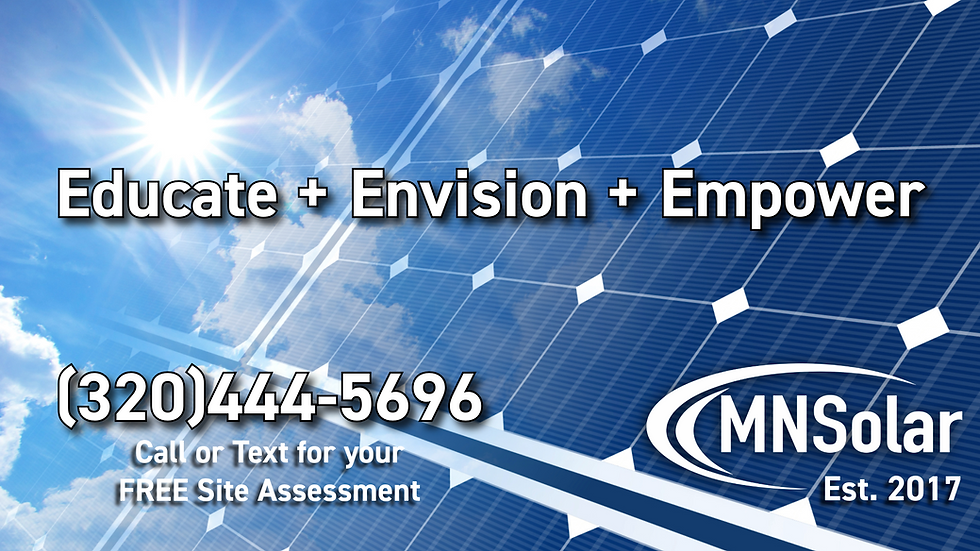Why Solar Energy Production Peaks in April and May in Minnesota
When we think of solar power, the hottest months of summer often come to mind as the ideal time for energy generation. However, in Minnesota, the best months for solar energy production are often April and May. You might be surprised to learn that, despite the chilly temperatures, these months outperform the summer months in terms of energy generation. So, why does solar energy shine brightest in the spring, especially in a northern state like Minnesota?
The Role of Temperature in Solar Panel Efficiency
One of the most important factors that influence the efficiency of solar panels is temperature. It may sound counterintuitive, but the performance of solar panels is actually negatively impacted by high temperatures. This is because solar panels operate by converting sunlight into electricity, and as their temperature rises, the resistance in the panel's electrical circuitry increases, which in turn reduces the overall energy output.
In warmer months, particularly during the summer, solar panels can overheat, resulting in a phenomenon called "thermal loss" or "heat-induced performance degradation." As the temperature rises, the solar cells experience more resistance, reducing their efficiency and the amount of energy they can produce.
In contrast, spring months like April and May bring cooler temperatures to Minnesota, which helps solar panels maintain optimal performance. During these months, even though the sunlight hours are increasing, the cooler temperatures prevent the panels from overheating, allowing them to operate at their maximum efficiency.
Longer Days and Increased Sunlight
April and May also mark a time when daylight hours are significantly longer compared to the winter months. As we move past the vernal equinox in March, the sun's trajectory shifts, and the length of the day gradually increases. By the time we reach April and May, Minnesota experiences up to 13-15 hours of daylight, compared to just 9 hours during the depths of winter.
This longer exposure to sunlight contributes to the increase in solar energy production. In fact, the intensity of sunlight—often referred to as solar insolation—is higher during the spring months than in the winter, meaning solar panels receive more sunlight during these months. The increased number of sun hours combined with lower temperatures creates the perfect balance for maximum energy output.

The Science Behind Solar Panel Performance
Solar panels operate through a photovoltaic (PV) process, where sunlight is absorbed by the panel's semiconductor material, usually silicon (always what we use), and converted into electricity. The efficiency of this conversion is determined by several factors, but temperature plays a critical role. As the temperature of the solar cells increases, the bandgap of the semiconductor material narrows, which leads to a loss of electrical potential. This is why solar panels are generally less efficient in hotter conditions.
In April and May, the solar panels benefit from the "sweet spot" of optimal sunlight without excessive heat. For instance, while the ideal temperature range for solar panel operation is between 59°F and 77°F (15°C to 25°C), Minnesota's spring temperatures typically hover in this ideal range, ensuring maximum efficiency and energy production.

Solar Energy in Minnesota: Local Factors at Play
Minnesota, known for its cold winters and mild summers, presents a unique opportunity for solar energy. The state's geographical location in the northern part of the U.S. means that solar panels have an advantage in the spring due to lower overall temperatures and extended daylight hours. Even though the sun might not shine as directly in winter, the state's spring months offer an ideal balance of cold, sunny weather—perfect for solar production.
Furthermore, the trend toward more advanced and efficient solar panels in recent years has made solar power more reliable in all seasons. Modern solar panels have improved heat tolerance, better insulation, and advanced cooling technologies that further help mitigate temperature-related losses. As a result, Minnesota residents can harness solar power efficiently throughout the year, but especially during the spring months.

Final Thoughts: Spring’s Optimal Solar Energy Performance
In conclusion, the best months for solar energy production in Minnesota—April and May—are the result of a combination of factors, including cooler temperatures, increased daylight hours, cleaner panels post-snowmelt, and optimal solar panel efficiency. By maintaining cooler operating conditions and benefiting from extended sunlight exposure, solar panels produce energy at their peak during these spring months.
While summer might be associated with high solar production in many parts of the world, Minnesota’s unique climate allows April and May to take center stage in maximizing solar energy output. Understanding these nuances of solar power production can help Minnesota residents, businesses, and policymakers make the most of their solar energy systems during the most productive months of the year.
Conclusion: Get Your Solar System Installed in 90 Days or Less
If you're ready to take advantage of Minnesota's optimal solar energy production months and start saving on your energy bills, now is the perfect time to act. With our streamlined process, we can design, plan, and install your solar system in 90 days or less. Our team of experts will guide you every step of the way, ensuring a smooth and efficient installation that maximizes your energy savings.
Don’t wait for summer to experience the benefits of solar power—reach out today to get started and take full advantage of Minnesota's peak solar production in April and May. Contact us to schedule a consultation and make the switch to clean, renewable energy with minimal hassle and maximum results.
Our quotes are free, informative and customized to your home. Give us a call or send us a message to get started.
Still have questions? Send us a note, info@MNSolarandMore.com
Wishing you many sunny days ahead!
Your MN Solar Team
Direct: (320)444-5696


Comentarios